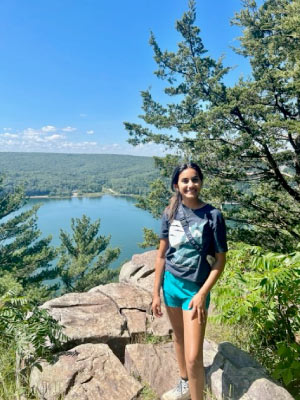
Soumika Gaddameedi’s passion for the environment began at a young age, stemming from childhood memories of hiking and surrounding herself with nature. When she was seven, her parents took her on a road trip to several national parks, including Yellowstone and Badlands. To Gaddameedi, the trip was “pivotal to realizing the beauty and wonders of nature.”
While in high school, Gaddameedi signed up for the AP environmental science course, kick-starting her educational path in the field. “I was really interested in learning about climate change and how natural cycles and systems work together,” she says. Yet when Gaddameedi started college, she set out on the pre-vet track (which had been her plan since kindergarten), declaring a major in zoology and only taking environmental studies courses for fun.
As Gaddameedi worked through her first few years in college, she fell in love with environmental studies and decided to add it as a second major. Since much of her environmental studies coursework correlated with that of the sustainability certificate, she decided to add that as well, wanting to open doors for her future. “Even though the environmental studies and sustainability courses were similar, I liked how each delved into different types of human-environment interactions,” Gaddameedi says.
After a wildlife rehabilitation internship with the Wisconsin Humane Society in Milwaukee, Gaddameedi became less sure that she wanted to continue to pursue a career as a veterinarian. “It was an amazing experience to spend the summer watching various wildlife species grow up before my very eyes, but I realized that I couldn’t do animal care long term because it was so physically draining,” she says. Thankfully,the Natural Resources Foundation’s Diversity in Conservation Internship broadened her horizons to career opportunities that would allow her to help wildlife, but wouldn’t be as demanding. To Gaddameedi, the program was “critical in shifting her career path” to conservation.

Gaddameedi’s biggest piece of advice for college students is to “try everything. It’s so much easier to find opportunities while you’re a student; it really helps you make connections with people in the field you’re going into.” During her undergraduate experience, Gaddameedi spent several years on the executive board of the Wisconsin Society for Conservation Biology (WSCB). Managing the chapter is what piqued her interest in nonprofit management, which is where she’s found a career today.
Last winter, Gaddameedi graduated from UW–Madison with a major in zoology and environmental studies and a certificate in sustainability. She now works for the NRF as an event and donor relations coordinator, where she manages events and fundraising. Her biggest undertaking in this position is planning the Great Wisconsin Birdathon, which is the largest bird conservation event in the state and sees over 500 participants each year.
During the 2023 Great Wisconsin Birdathon, 72 teams worked together to raise over $120,000 for bird conservation across the state. “This was the 12th year of the Birdathon, and what started as a small, impromptu event has grown into a massive, inclusive event where people can participate in whichever way works best for them,” Gaddameedi says. Some of the Birdathon’s participants partake in 24-hour birding excursions, taking pledges for the different bird species they spot, while others go bird-watching more casually. Either way, the event was — and will continue to be — a win-win for Wisconsin’s birds and birders.
In the future, Gaddameedi hopes to work up to a higher position in a nonprofit organization. “I really like working with volunteers and I enjoyed managing the executive board in WSCB, so I would like to be some form of a nonprofit manager and inspire more advocates for the outdoors,” she says. With her background in environmental studies, Gaddameedi wants to encourage more people to take time in understanding nature and the ecosystems flourishing around us. She says, “[the changing climate] affects everyone. Even if it’s not your job, you can incorporate conservation into any field, which is what needs to be done.”